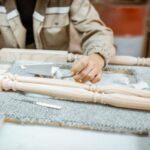Introduction
Woodworking can be a very enjoyable and rewarding hobby but it is important to remember that woodworking is not without its risks. One of the main health risk associated with woodworking is hearing loss due to prolonged exposure to loud noises. Noise levels in woodworking typically range from 90-119 dB which is well above the safe level for humans of 85 dB. This kind of prolonged exposure could result in permanent damage to your hearing over time, including tinnitus and deafness. To minimize this risk, it is important to make use of appropriate hearing protection.
Hearing protection typically consists of specialized earmuffs or earplugs that help reduce sound levels while still allowing users to hear what they are working on. Earmuffs also help provide a comfortable fit while also helping block out excess noise created by passing vehicles or other distractions in the area while you work. Earplugs work by creating an airtight seal inside the ear canal, which helps protect your eardrums from any particularly loud sounds being produced. Additionally, some hearing protection products come with advanced features such as Bluetooth technology, which allows users to link their audio device directly into their earplugs for enhanced sound control. It’s important to select hearing protection designed specifically for woodworking as this will offer wearers the most effective level of sound reduction.
In addition to wearing proper hearing protection safety gear, it’s important to take regular noise breaks when doing woodworking projects and reduce sound levels wherever possible using noise dampening materials such as rubber mats and thick foam blocks around machines and tools. Regular testing should also be performed monthly to ensure that all machines are operating at safe volumes according to workplace standards. By taking these measures and equipping yourself with quality hearing protection, you can help ensure a safe working environment while enjoying all the rewards of your hobby!
Exploring Different Types of Woodworking
When it comes to woodworking, hearing protection is essential. Not only does it protect your ears from the noise of power tools, but it is also critical for preventing hearing loss in the long term. There are many different types of woodworking hearing protection that you can use, depending on the type and intensity of the project.
For lighter projects such as sanding or routing, consider using standard heavy-duty earmuffs or comfortable earbuds. These types of ear protection block out most loud noises produced by lower powered machines and provide superior comfort due to their lightweight materials. They are also affordable, making them great for those just starting out with woodworking.
For more intense woodwork activities such as chainsawing or high-speed drilling, opt for formable earplugs that are designed specifically to filter out higher dB levels while still allowing you to hear other sounds in the environment. Such specialized filters can also be custom molded to fit your ears perfectly adn provide an additional layer of security against damaging noises. You can even find double-cap earplugs that offer two layers of sound insulation for extra protection against dangerous volumes and debris flying in your direction.
Finally, don’t forget about in-ear monitors for when you need to go mobile during a project but still want some hearing protection from extreme noise levels. These are inserted into your canal and act as a barrier between inner and outer ear surfaces without compromising on sound clarity – perfect for jobs that require movement or distance from the work area.
Understanding the Different Types of Hearing Protection
Woodworking can be a noisy activity and it is important to wear the appropriate hearing protection when operating an array of tools. There are several different kinds of hearing protection available, each with its own benefits and features.
Earplugs: Earplugs are small, soft rubber or foam plugs that fit into the ear canal. They are effective at blocking out louder noise levels and can be easily stored in a pocket. They also provide some degree of comfort as they create an air-tight seal in the ear canal.
Ear Muffs: Ear muffs are usually made of plastic or metal with heavily padded cushions around them. They typically have an adjustable headband that fits over your ears. Ear muffs offer extreme protection and block out even higher noise levels than earplugs. They also provide a comfortable fit and the ability to customize their sound-blocking properties with removable parts like foam cushioning or other materials.
Helmets: Helmets come in either full face or open face styles and they feature hard plastic construction and thick padding that offers excellent protection from flying particles and debris, as well as loud noises from power tools such as saws, drills, planers, etc.. The helmets come with optional add-on features such as face shields for safety glasses, communication systems, respirators for dust mask applications, or shields for neck protection from headlamp glare during nighttime working hours.
Minimizing Noise At Source: When working with woodworking tools it is important to make sure you practice proper noise reduction techniques to minimize the loud noises created by operation of the tool itself. This can include muffling pieces such as shrouds on grinders or circular saws to deflect sound away from your ears, installing noise dampening mats beneath machinery, staying at least three feet away from running machinery while in use, utilizing lower speed settings on equipment (if applicable), and always using properly functioning dust collection systems when operating sanders or planers.
Investigating the Benefits of Using Hearing Protection
Woodworking is considered to be one of the loudest professions, often reaching 102 dB or higher on a consistent basis. To protect the hearing of workers, hearing protection is necessary in any woodworking workplace. It’s important for employers to provide the necessary tools to ensure that everyone is protected from loud noises. Benefits from using hearing protection include:
1. Improved Health: Using hearing protection can help reduce exposure to extreme noises and lower stress levels as a result, improving overall health and wellbeing. Additionally, avoiding noise-induced deafness can help prevent further complications such as tinnitus, a condition resulting from damage of the auditory system which causes ringing in the ear or hearing loss over time.
2. Increased Productivity: Reducing exposure to high levels of sound can help improve concentration levels while working. With improved focus, workers may become more productive which could reduce instances of mistakes in the long run and save long-term operational costs for employers.
3. Economic Advantages: As mentioned prior, reducing errors caused by loud noise exposure can result in cost savings for employers down the line, including expenses related to increased safety measures or medical care due to conditions developed due to forgetting protective equipment such as earmuffs or earplugs. Wearing proper personal protective equipment (PPE) like hearing protection also protects workers from potential liabilities related to accident claims in case of an injury claim caused by inadequate safety measures being taken by their employer.
The Best Protective Gear for Woodworking
Woodworking projects can be loud and dangerous. Therefore, it is important to take the necessary precautions to protect your hearing when using tools for any project, especially if you will be in close proximity of them for prolonged periods of time. Hearing protection is essential for anyone engaging in this type of work to prevent long-term damage or even permanent hearing loss. The best protective gear for woodworking typically consists of ear muffs or ear plugs, which reduce sound levels by forming a barrier between the source of sound and the ear canal itself. Both are designed specifically to block out sudden and excessive noise, while allowing lower levels to pass freely through and reach the listener’s ears. They are also usually lightweight and comfortable, making them an ideal choice for woodworking projects and activities. In addition to providing protection from loud sounds, these items are also great for blocking out distracting noises that can impede focus and concentration while working on a project. To ensure maximum safety, it is advised that all workers wear proper protection when using power tools such as saws or drills that produce significant sound levels.
A Guide to Finding the Right Hearing Protection for Your Needs
Woodworking projects can create a tremendous amount of noise that can put your hearing at risk. Safety should always be front-of-mind when dealing with loud power tools, such as saws and sanders, and it’s essential to protect your ears from the high volume sounds generated by these tools. Hearing Protection is the best way to reduce your exposure to noise levels that could be damaging and provide long-term hearing protection.
When it comes to finding the right hearing protective device for woodworking, you’ll want to ensure it meets two main criteria: Comfort and Noise Reduction Rating (NRR). Comfort is important because you’ll need to wear the hearing protection for extended periods of time; if it’s uncomfortably bulky or too tight, you won’t want to wear it.
The NRR measures how much sound is blocked; the higher the rating, the better. You will want a device or earmuffs with an NRR of 25 dB or higher; this means it will block out 85% of all sound waves coming in contact with your ears. Additionally, look for products that are moisture resistant, lightweight and adjustable for maximum comfort.
Finally, consider whether you’d prefer an electronic hearing protector which allow some sound through while dampening loud noises. These may be suitable for certain tasks where clear communication is necessary such as when working with others who need to converse throughout their projects. Whatever product you choose make sure its comfortable enough so that you won’t feel tempted take it off throughout your projects – thereby protecting yourself from any loud noises that could potentially damage your hearing in the long run.
Best Practices for Wearing Hearing Protection
Woodworking can be an incredibly loud and hazardous activity, especially when using power tools like saws, grinders, and other machines. One of the best ways to protect your hearing while woodworking is to wear hearing protection. Hearing protection products range from foam earplugs to full-coverage earmuffs. Some even feature electronics that help you hear conversations while simultaneously protecting your ears from damaging sound levels.
When choosing a form of hearing protection, it’s important to consider the type of woodworking you are doing and what frequency ranges you plan on working in. For example, if you are mostly cutting with a saw then a headset-style product may be more beneficial than plain foam earplugs. Additionally, if you’ll be using multiple tools then look for adjustable products or models specifically designed for multiple applications. It’s also important to make sure the hearing protection is comfortable and fits properly as these can affect how well the product works in reducing noise levels.
Before putting your ears at risk by not wearing appropriate hearing protection, make sure to take some time in researching what type of products best fit your needs. Every day since decisions taken today lay strong foundations for tomorrow so make sure that proper hearing protection is always used during woodworking projects and other loud activities!
Final Thoughts
When it comes to woodworking, safety should be a priority. With regular exposure to the loud machinery used for cutting and sawing, hearing protection is essential for protecting your ears. Properly equipped with the proper fitted earmuffs, plugs, or bands, you can take all necessary precautions and look after your ear health. You can find a variety of options at local hardware stores and online retailers that feature comfortable and durable models designed for optimal wear and protection. Additionally, you can use tools like sound meters to measure the noise levels in your workshop so that you know exactly how much protection is needed and which type of protective gear is best suited to it. By taking into account these important considerations when using any woodworking power tool, you can protect those around you while protecting yourself from potential harm. Whether detailed craftsmanship is involved or simpler construction projects are in progress – always pay attention to the noise levels generated by your equipment and by ensuring that proper hearing protection is in place before beginning any job. Doing this will go a long way towards keeping your ears healthy and allowing you to continue enjoying the benefits of engaging in woodworking crafts.

Hi everyone! I’m a woodworker and blogger, and this is my woodworking blog. In my blog, I share tips and tricks for woodworkers of all skill levels, as well as project ideas that you can try yourself.





